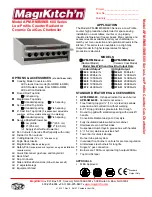
INSTALLATION
2-9
2.10.4 B.M.S. (PWM) IN
NOTE
Only BMS Model 168 can utilize Pulse
Width Modulation (PWM), not the BMS II
(Model 5R5-384).
These terminals are used to connect the
AERCO Boiler Management System (BMS) to
the unit. The BMS utilizes a 12 millisecond,
ON/OFF duty cycle. This duty cycle is Pulse
Width Modulated (PWM) to control the air/fuel
valve position. A 0% (open) air/fuel valve
position = a 5% ON pulse and a 100% open
valve position = a 95% ON pulse.
2.10.5 SHIELD
The SHIELD terminals are used to terminate any
shields used on sensor wires connected to the
unit. Only shields must be connected to these
terminals.
IMPORTANT
DO NOT USE the mA OUT output to
remotely monitor Setpoint, Outlet Temp or
Fire Rate Out.
2.10.6 mA OUT
These terminals provide a 4 to 20 mA output to
the VFD (if so equipped) to control the rotational
speed of the blower. This function is enabled in
the Configuration Menu (Chapter 3, Table 3-4).
2.10.7 0 – 10V OUT
These terminals provide a 0 to 10V output to
control the rotational speed of the blower. This
function is enabled in the Configuration Menu
(Chapter 3, Table 3-4).
2.10.8 RS-485 COMM
These terminals are used for RS-485 MODBUS
serial communication between the unit and an
external “Master” such as a Boiler Management
System (BMS), Energy Management System
(EMS), Building Automation System (BAS) or
other suitable device.
2.10.9 EXHAUST SWITCH IN
These terminals permit an external exhaust
switch to be connected to the exhaust manifold
of the boiler. The exhaust switch should be a
normally open type switch
(such as AERCO Part
No. 123463) that closes (trips) at 500°F.
2.10.10 INTERLOCKS
The unit offers two interlock circuits for
interfacing with Energy Management Systems
and auxiliary equipment such as pumps or
louvers. These interlocks are called the Remote
Interlock and Delayed Interlock (Figure 2-10).
The wiring terminals for these interlocks are
located inside the I/O Box on the unit front
panel. The I/O Box cover contains a wiring
diagram which shows the terminal strip locations
for these interlocks (REMOTE INTL’K IN and
DELAYED INTL’K IN). Both interlocks,
described below, are factory wired in the closed
position.
NOTE
Both the Remote Interlock and Delayed
Interlock MUST be in the closed position
to allow the unit to fire.
2.10.10.1
REMOTE INTERLOCK IN
The remote interlock circuit is provided to
remotely start (enable) and stop (disable) the
Boiler, if desired. The circuit is labeled REMOTE
INTL’K IN and is located inside the I/O Box on
the front panel. The circuit is 24 VAC and is
factory pre-wired in the closed (jumpered)
position.
2.10.10.2
DELAYED INTERLOCK IN
The delayed interlock is typically used in
conjunction with the auxiliary relay described in
paragraph 2.10. This interlock circuit is located
in the purge section of the start string. It can be
connected to the proving device (end switch,
flow switch etc.) of an auxiliary piece of
equipment started by the Boiler’s auxiliary relay.
The delayed interlock must be closed for the
boiler to fire.
If the delayed interlock is connected to a proving
device that requires time to close (make), a time
delay (Aux Start On Dly) that holds the start
sequence of the boiler long enough for a proving
switch to make can be programmed. Should the
proving switch not prove within the programmed
time frame, the boiler will shut down. The Aux
Start On Dly can be programmed from 0 to 120
seconds. This option is locate in the
Configuration Menu (Chapter 3, Table 3-4).
2.10.11 FAULT RELAY
The fault relay is a single pole double throw
(SPDT) relay having a normally open and
normally closed set of relay contacts that are
rated for 5 amps at 120 VAC and 5 amps at 30
VDC. The relay energizes when any fault
condition occurs and remains energized until the
Summary of Contents for Benchmark 2.0
Page 4: ......
Page 8: ......
Page 12: ......
Page 24: ......
Page 44: ......
Page 50: ......
Page 78: ......
Page 84: ......
Page 88: ......
Page 90: ......
Page 101: ...APPENDIX F F 5 ...
Page 102: ...APPENDIX F F 6 ...
Page 104: ...APPENDIX F F 8 ...
Page 105: ...APPENDIX F F 9 ...
Page 106: ...APPENDIX F F 10 ...
Page 107: ...APPENDIX F F 11 ...
Page 108: ...APPENDIX F F 12 ...
Page 112: ...APPENDIX G G 4 ...
Page 113: ...APPENDIX H H 1 ...
Page 114: ...APPENDIX H H 2 ...
Page 115: ...APPENDIX H H 3 ...
Page 118: ......
Page 119: ...APPENDIX J BENCHMARK CONTROL PANEL EXPLODED VIEW J 1 ...
Page 120: ...APPENDIX J J 2 P1 P2 P3 P4 P5 P6 BENCHMARK CONTROL PANEL REAR VIEW ...
Page 122: ......
















































